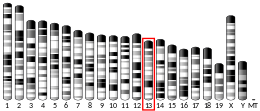Docking protein 3 is a protein that in humans is encoded by the DOK3 gene.[5][6][7]
References
edit- ^ a b c GRCh38: Ensembl release 89: ENSG00000146094 – Ensembl, May 2017
- ^ a b c GRCm38: Ensembl release 89: ENSMUSG00000035711 – Ensembl, May 2017
- ^ "Human PubMed Reference:". National Center for Biotechnology Information, U.S. National Library of Medicine.
- ^ "Mouse PubMed Reference:". National Center for Biotechnology Information, U.S. National Library of Medicine.
- ^ Lemay S, Davidson D, Latour S, Veillette A (Apr 2000). "Dok-3, a Novel Adapter Molecule Involved in the Negative Regulation of Immunoreceptor Signaling". Mol Cell Biol. 20 (8): 2743–54. doi:10.1128/MCB.20.8.2743-2754.2000. PMC 85490. PMID 10733577.
- ^ Favre C, Gerard A, Clauzier E, Pontarotti P, Olive D, Nunes JA (Feb 2003). "DOK4 and DOK5: new Dok-related genes expressed in human T cells". Genes Immun. 4 (1): 40–5. doi:10.1038/sj.gene.6363891. PMID 12595900. S2CID 24417010.
- ^ "Entrez Gene: DOK3 docking protein 3".
Further reading
edit- Cong F, Yuan B, Goff SP (2000). "Characterization of a Novel Member of the DOK Family That Binds and Modulates Abl Signaling". Mol. Cell. Biol. 19 (12): 8314–25. doi:10.1128/MCB.19.12.8314. PMC 84915. PMID 10567556.
- Grimm J, Sachs M, Britsch S, Di Cesare S, Schwarz-Romond T, Alitalo K, Birchmeier W (2001). "Novel p62dok family members, dok-4 and dok-5, are substrates of the c-Ret receptor tyrosine kinase and mediate neuronal differentiation" (PDF). J. Cell Biol. 154 (2): 345–54. doi:10.1083/jcb.200102032. PMC 2150770. PMID 11470823.
- Strausberg RL, Feingold EA, Grouse LH, Derge JG, Klausner RD, Collins FS, Wagner L, Shenmen CM, Schuler GD (2003). "Generation and initial analysis of more than 15,000 full-length human and mouse cDNA sequences". Proc. Natl. Acad. Sci. U.S.A. 99 (26): 16899–903. Bibcode:2002PNAS...9916899M. doi:10.1073/pnas.242603899. PMC 139241. PMID 12477932.
- Ota T, Suzuki Y, Nishikawa T, Otsuki T, Sugiyama T, Irie R, Wakamatsu A, Hayashi K, Sato H (2004). "Complete sequencing and characterization of 21,243 full-length human cDNAs". Nat. Genet. 36 (1): 40–5. doi:10.1038/ng1285. PMID 14702039.
- Robson JD, Davidson D, Veillette A (2004). "Inhibition of the Jun N-Terminal Protein Kinase Pathway by SHIP-1, a Lipid Phosphatase That Interacts with the Adaptor Molecule Dok-3". Mol. Cell. Biol. 24 (6): 2332–43. doi:10.1128/MCB.24.6.2332-2343.2004. PMC 355862. PMID 14993273.
- Gerhard DS, Wagner L, Feingold EA, Shenmen CM, Grouse LH, Schuler G, Klein SL, Old S, Rasooly R (2004). "The Status, Quality, and Expansion of the NIH Full-Length cDNA Project: The Mammalian Gene Collection (MGC)". Genome Res. 14 (10B): 2121–7. doi:10.1101/gr.2596504. PMC 528928. PMID 15489334.
- Honma M, Higuchi O, Shirakata M, Yasuda T, Shibuya H, Iemura SI, Natsume T, Yamanashi Y (2007). "Dok-3 sequesters Grb2 and inhibits the Ras-Erk pathway downstream of protein-tyrosine kinases". Genes Cells. 11 (2): 143–51. doi:10.1111/j.1365-2443.2006.00926.x. PMID 16436051. S2CID 42571721.




